Stillborn 80.002 Shooting Complex
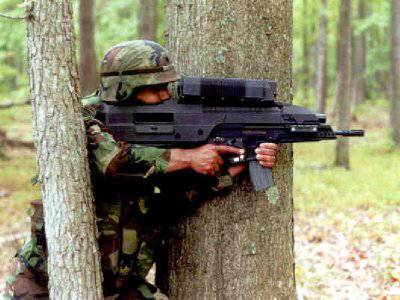 To begin with, let's briefly go over what the Americans got from their development, so to speak, so that there is something to compare with. The basis of such weapons in the United States, developed under the OICW program, was a programmable shot in two versions - 20 caliber of millimeters and 25 of millimeters. Naturally, everyone understood the lower efficiency of such a munition in comparison with 40 millimeter shots, which is why it was not a completely conventional design. The fact is that the fuse of such a shot is programmable in time. Weapons for such shots are equipped with a range finder, with which the distance to the target is measured, the flight speed is known, respectively, it is not difficult for the electronics to automatically calculate the flight time for which the projectile will reach the target and transfer this time to the fuse. Thus, the explosion takes place on the approach to the target, which significantly increases the effectiveness of such ammunition.
To begin with, let's briefly go over what the Americans got from their development, so to speak, so that there is something to compare with. The basis of such weapons in the United States, developed under the OICW program, was a programmable shot in two versions - 20 caliber of millimeters and 25 of millimeters. Naturally, everyone understood the lower efficiency of such a munition in comparison with 40 millimeter shots, which is why it was not a completely conventional design. The fact is that the fuse of such a shot is programmable in time. Weapons for such shots are equipped with a range finder, with which the distance to the target is measured, the flight speed is known, respectively, it is not difficult for the electronics to automatically calculate the flight time for which the projectile will reach the target and transfer this time to the fuse. Thus, the explosion takes place on the approach to the target, which significantly increases the effectiveness of such ammunition. And everything would be great if it were not for the small weight of the fragments of a similar shot, which negate the effectiveness of the ammunition. Many weapons were created on the basis of this munition, and even an attempt was made to create such a hybrid as a grenade launcher and a sniper rifle, but this did not lead to anything good. Perhaps the only more or less justifiable weapon for a given ammunition is the XM307 grenade launcher, which in a few minutes can become an XM312 - a large-caliber machine gun for the .50BMG cartridges. Using 25 millimeter shots, this grenade launcher shoots 250 shots per minute, which makes it quite effective, however, with a fairly high cost of one shot, the advantages of this ammunition and weapons for it become significantly less. It should be noted that a similar idea migrated to many other countries, for example, in South Korea, the Daewoo K11 complex was being developed, the future of which is also unknown. In other words, the future of such ammunition and weapons to it is already known, and, most likely, they will have no future, which cannot but cause a malevolent smirk, since it took 20 years for US military officials to understand this.
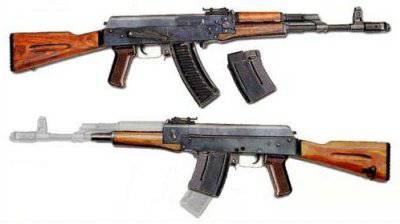 In our country, this process took place much more quickly. So the very idea of reducing the caliber of shots was born in the 1973 year, it was then that V. S. Yakushev suggested creating an automatic-grenade launcher complex for non-standard shots of a smaller caliber. It is not clear for what reasons, but they decided to make a shot in caliber 12,7 millimeters, but not on the basis of the cartridge 12,7х108, as usually written in specialized publications. The new shot was very similar to the large-caliber subsonic cartridge SP-130 and the like. Looking ahead, there are suggestions that it was this shot that served as the basis for the 12,7x55 cartridges, which at least partially justified the development of the 80.002 rifle complex. Information on the 12,7 caliber shot of millimeters is really very small in open sources, the only thing that can be said is that without a doubt this ammunition was very, very weak. However, if hit directly on the enemy, the effect would be significant, but the effect from a bullet hit is, albeit not so large.
In our country, this process took place much more quickly. So the very idea of reducing the caliber of shots was born in the 1973 year, it was then that V. S. Yakushev suggested creating an automatic-grenade launcher complex for non-standard shots of a smaller caliber. It is not clear for what reasons, but they decided to make a shot in caliber 12,7 millimeters, but not on the basis of the cartridge 12,7х108, as usually written in specialized publications. The new shot was very similar to the large-caliber subsonic cartridge SP-130 and the like. Looking ahead, there are suggestions that it was this shot that served as the basis for the 12,7x55 cartridges, which at least partially justified the development of the 80.002 rifle complex. Information on the 12,7 caliber shot of millimeters is really very small in open sources, the only thing that can be said is that without a doubt this ammunition was very, very weak. However, if hit directly on the enemy, the effect would be significant, but the effect from a bullet hit is, albeit not so large.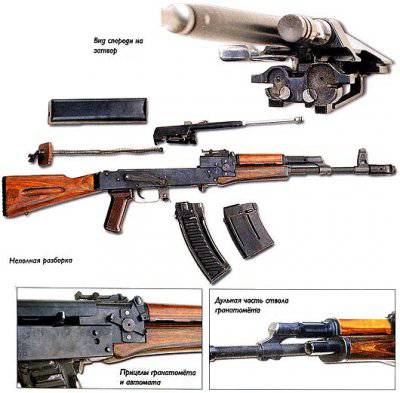 Officially, the development of weapons for this ammunition was conducted from 1975 to 1979 year. The result of this development was quite an interesting automaton, but it was not even brought to a more or less usable version. The basis for the new complex, as it is not difficult to guess, was the Kalashnikov 74 of the year. Without further ado, the weapon was made a wider receiver, in which a double bolt and a second barrel were placed under the new ammunition. If you look at the images of this weapon, it becomes clear that the model is very, very raw. First of all, there is a lack of windows for ejection of spent cartridges, but with the use of a sleeveless cartridge it is in no way connected, the fastest way to photograph was given only to the sample that was collected in order to see how all this ugliness will look. The presence of a double bolt in the weapon is also clearly not the final option, since it’s not at all clear how 80.002 can work with it, although you can fantasize about this topic, of course, but imagine how this piece of metal with a mass obviously more than one and a half kilogram will move with automatic fire, scary, and the 5,45x39 cartridge is unlikely to be enough to ensure the normal operation of the automation with a shutter of such a weight, unless, of course, a different principle of the operation of the weapon’s weapons other than AK was chosen.
Officially, the development of weapons for this ammunition was conducted from 1975 to 1979 year. The result of this development was quite an interesting automaton, but it was not even brought to a more or less usable version. The basis for the new complex, as it is not difficult to guess, was the Kalashnikov 74 of the year. Without further ado, the weapon was made a wider receiver, in which a double bolt and a second barrel were placed under the new ammunition. If you look at the images of this weapon, it becomes clear that the model is very, very raw. First of all, there is a lack of windows for ejection of spent cartridges, but with the use of a sleeveless cartridge it is in no way connected, the fastest way to photograph was given only to the sample that was collected in order to see how all this ugliness will look. The presence of a double bolt in the weapon is also clearly not the final option, since it’s not at all clear how 80.002 can work with it, although you can fantasize about this topic, of course, but imagine how this piece of metal with a mass obviously more than one and a half kilogram will move with automatic fire, scary, and the 5,45x39 cartridge is unlikely to be enough to ensure the normal operation of the automation with a shutter of such a weight, unless, of course, a different principle of the operation of the weapon’s weapons other than AK was chosen.In view of the fact that nothing is known about weapons at all, speculation and fantasies began to gather around him, so one of the most common assumptions is that in this type of weapon blank cartridges were used, not shots, the shots themselves were put on the second barrel of the weapon. If you look more closely, it becomes immediately clear that it is not possible to realize such an opportunity for the second barrel, since the barrels are very close to each other, and such an energy cartridge is not needed to launch the caliber shots. In addition, the ability to launch such ammunition was at the first barrel caliber 5,45. The second widespread opinion is that this version of the weapon did not have a grenade launcher at all, but used two types of ammunition, one of which was designed to damage lightly armored vehicles and protected enemy personnel with personal armor. This could have been believed to be faster, and the niche for using such weapons is quite obvious, but nevertheless it was a grenade launcher, although I personally don’t turn my tongue to call something X-mm caliber of a grenade launcher and ammunition with a shot, rather cartridge with bursting bullet. In proof that the weapon has a grenade launcher, you can bring separate sighting devices that are clearly intended for a grenade launcher.
As already described above, the weapon is actually two different devices that are placed in one body. The complex is supplied from separate stores with 5,45х39 cartridges with a capacity of 30 cartridges and grenade rounds of 12,7 caliber of millimeters with a capacity of 10 shots. Both stores are located in front of the trigger next to each other, which naturally has a negative effect on the convenience of a replacement, but this can easily be attributed to the fact that the model is experimental and would have somehow solved this problem if the idea had been further developed. But the development was not in view of the very low effectiveness of a grenade launcher shot and refused to develop further. In other words, in order to understand that a 40 millimeter shot is the minimum for a grenade launcher in the USSR it took less than 7 years, taking into account the time taken to manufacture weapons for this type of ammunition and the ammunition itself. But those who think that this time was wasted are deeply mistaken. Despite the fact that the project was officially stopped in the 1979 year, this prototype was used to refine many design solutions up to the 90s. And in 2002, this project back proved that the money was spent on it was not for nothing, because on the basis of the shot a special cartridge 12,7x55 appeared, which, I will note once again, is only a hunch that no one is in a hurry to confirm, but the similarity of ammunition is too explicit, so as not to notice.
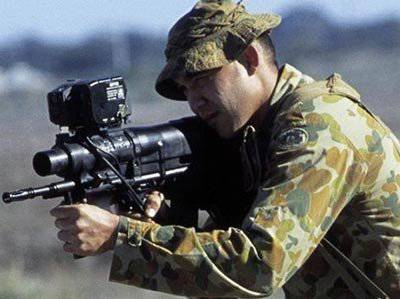 In general, of course, it is incorrect to compare simple 12,7 caliber shots of millimeters with programmable shots, since the ideas are essentially different, but the fact that reducing the caliber of the shot doesn’t lead to anything good proves both the first and second options. At this time, stopping the project to create new weapons really saved a lot of time and money, and as a result received from this development even more than in the US. Of course, you can nod at 20 caliber large-caliber sniper rifles millimeters, the range of ammunition includes high-explosive fragmentation projectiles, but even the effectiveness of such ammunition does not reach normal grenades, they are designed to damage equipment, or destroy light shells, such as brickwork but not for use instead of a full-fledged grenade launcher.
In general, of course, it is incorrect to compare simple 12,7 caliber shots of millimeters with programmable shots, since the ideas are essentially different, but the fact that reducing the caliber of the shot doesn’t lead to anything good proves both the first and second options. At this time, stopping the project to create new weapons really saved a lot of time and money, and as a result received from this development even more than in the US. Of course, you can nod at 20 caliber large-caliber sniper rifles millimeters, the range of ammunition includes high-explosive fragmentation projectiles, but even the effectiveness of such ammunition does not reach normal grenades, they are designed to damage equipment, or destroy light shells, such as brickwork but not for use instead of a full-fledged grenade launcher.The use of electronics combined with 40 millimeter shots turned out to be a much more reasonable approach. I would like to note not everyone’s favorite FN F2000 and its further development, but the Australian rifle complex developed under the AIWC program, similar to the American one. As a result, on the basis of the Steyr AUG, a rather massive weapon with an awkward appearance was created, which fully equipped weighs 9,9 a kilogram. It is noted that the weapon is perfectly balanced, so overweight interferes only when it is worn, and when fired, the opposite effect is positive, making the complex stable. By the way, the weight of the weapon can be reduced if you remove a mini-computer from it which is both a night vision device and an optically sight and part of the development of "friend or foe" and what the hell. In this case, the basic principle of the weapon will not change. The range finder will still measure the distance to the target, count the flight time and transfer data to the fuse, well, the machine gun will shoot anyway, since by and large it is all the same Steyr AUG with a triple-charge grenade launcher. The question arises whether all this electronics is necessary in weapons, but that is already another story.
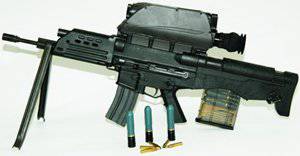 If we return to the 80.002 rifle complex, we would like to see its further development in the form of a machine gun, but without a grenade launcher, and with the additional possibility of using large-caliber cartridges, possibly even full-fledged 12,7x108. Such an opportunity would be useful if you hit targets protected by heavy body armor, stopping vehicles and other targets, it’s not always possible, and justified, to use 40 millimeter shots for this, and with the development of individual means of armor this possibility seems quite reasonable. At the same time, its implementation may not even require separate weapons, but may be made in the form of a removable device mounted under the barrel of the weapon, similar to a rifle grenade launcher. In other words, this project can be re-opened, but in a slightly different form.
If we return to the 80.002 rifle complex, we would like to see its further development in the form of a machine gun, but without a grenade launcher, and with the additional possibility of using large-caliber cartridges, possibly even full-fledged 12,7x108. Such an opportunity would be useful if you hit targets protected by heavy body armor, stopping vehicles and other targets, it’s not always possible, and justified, to use 40 millimeter shots for this, and with the development of individual means of armor this possibility seems quite reasonable. At the same time, its implementation may not even require separate weapons, but may be made in the form of a removable device mounted under the barrel of the weapon, similar to a rifle grenade launcher. In other words, this project can be re-opened, but in a slightly different form.Instead of PS
The Americans spent a lot of time and money on the development of a shot that would have exploded in the air, the shot itself turned out to be incredibly expensive to manufacture, and it also demanded a separate weapon. Domestic designers in the year 1979 was created shot VOG-25P, which could be used all in the same grenade launchers and which had absolutely no electronics in itself, not to mention the fact that by efficiency the domestic "foundling" leaves far behind all smart shots caliber 20 and 25 millimeters. Of course, abroad there are some “jumping” shots, the effectiveness of many of which is much higher than domestic ones, so a quite reasonable question arises, why was it necessary to spend so much money?
Information